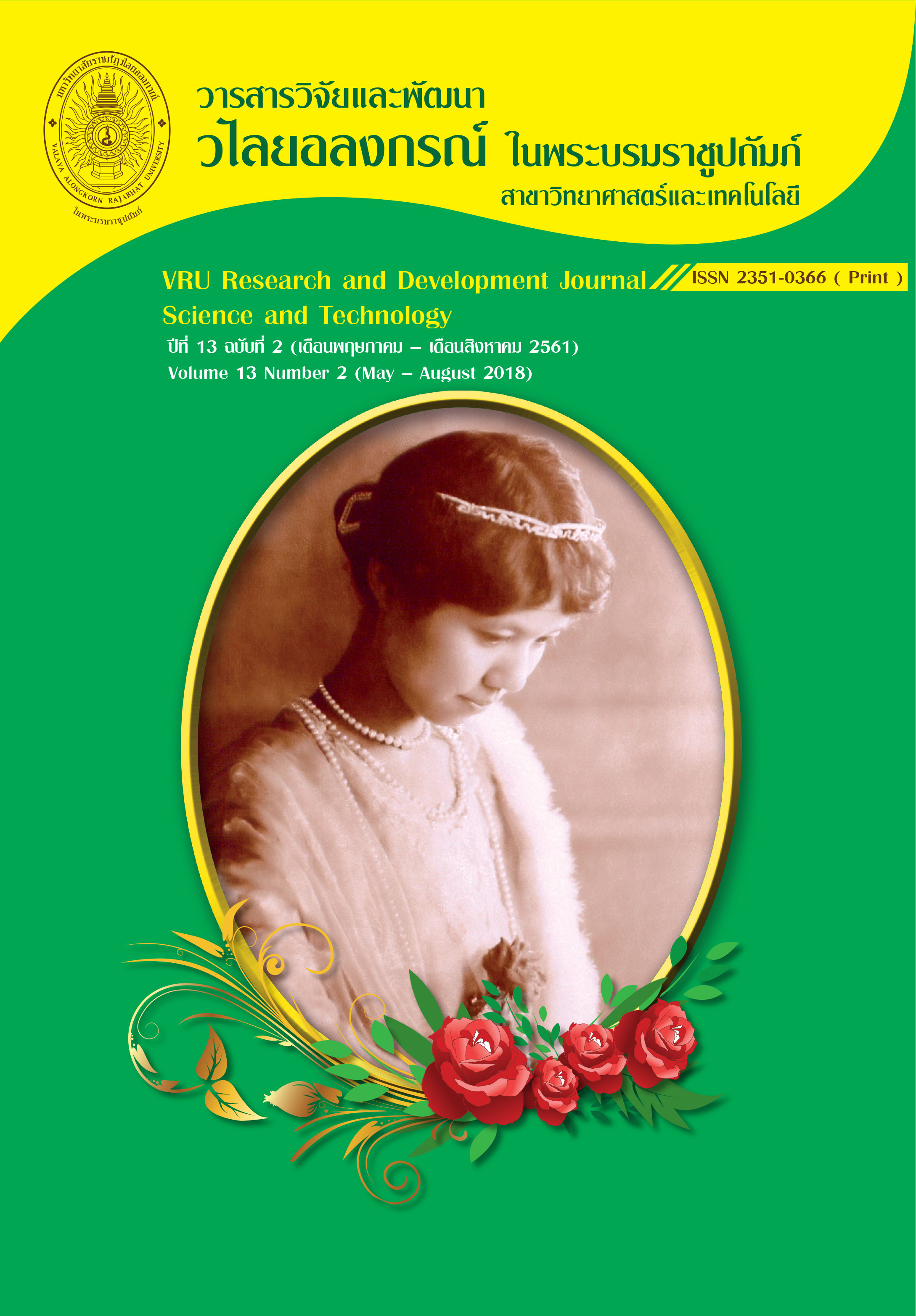การคัดเลือกแบคทีเรียที่สามารถผลิตกรดไขมันไม่อิ่มตัวสายยาวด้วยวิธีอย่างง่าย
Main Article Content
บทคัดย่อ
ในปัจจุบันกรดไขมันไม่อิ่มตัวสายยาว (polyunsaturated fatty acids, PUFAs) จัดว่าเป็นผลิตภัณฑ์ที่น่าสนใจในเป็นอย่างมาก เนื่องจากมีรายงานเกี่ยวกับบทบาทสำคัญต่อสิ่งมีชีวิตโดยเฉพาะอย่างยิ่งระบบการทำงานต่าง ๆ ในร่างกายมนุษย์ จึงเป็นที่นิยมในการพัฒนากรดไขมันไม่อิ่มตัวสายยาวให้เป็นผลิต ทางยาและการแพทย์ การวิจัยในครั้งนี้มีวัตถุประสงค์เพื่อคัดเลือกชนิดของแบคทีเรียจากตัวอย่างธรรมชาติ ด้วยวิธีการที่ง่ายและรวดเร็ว โดยอาศัยคุณสมบัติในการต้านสารอนุมูลอิสระของกรดไขมันไม่อิ่มตัวสายยาวที่ เชื้อแบคทีเรียสังเคราะห์ขึ้น โดยการทดสอบการเจริญของเชื้อแบคทีเรียบนอาหารเลี้ยงเชื้อที่มีสารไฮโดรเจนเปอร์ออกไซด์ที่ความเข้มข้น 0.1% ผลการทดลองพบว่าสามารถคัดเลือกเชื้อแบคทีเรียที่สังเคราะห์กรดไขมัน ไม่อิ่มตัวสายยาวได้จำนวน 5 ไอโซเลต ได้แก่ SS_Sa2, SS_Sa1.1, KT_W1Y, BK_PD3 และ BK_SD4 และจากการจัดจำแนกสายพันธุ์แบคทีเรียด้วยการศึกษาลำดับนิวคลีโอไทด์ของชิ้นส่วน 16S rDNA ร่วมกับการศึกษาความสัมพันธ์ของลำดับวิวัฒนาการ พบว่าแบคทีเรียไอโซเลต SS_Sa2, SS_Sa1.1, KT_W1Y, BK_PD3 และ BK_SD4 มีความใกล้เคียงกับแบคทีเรียสายพันธุ์ Pseudoxanthomanas sp., Bacillus subtilis, Burkholderia sp., Vibrio sp. และ Pseudomonas fluorescens ที่ความใกล้เคียงเท่ากับ 99, 98, 99, 97 และ 98 เปอร์เซ็นต์ ตามลำดับ ผลจากการศึกษาในครั้งนี้ทำให้ทราบถึงความหลากหลายของสายพันธุ์แบคทีเรียที่สามารถผลิตกรดไขมันไม่อิ่มตัวสายยาวได้ ซึ่งจะนำไปสู่การพัฒนาเป็นแหล่งของผลิตภัณฑ์อาหารเสริมสุขภาพหรือยารักษาโรคต่อไปในอนาคต
Article Details
ลิขสิทธิ์บทความวิจัยที่ได้รับการตีพิมพ์เผยแพร่ในวารสารวิจัยและพัฒนา วไลยอลงกรณ์ ในพระบรมราชูปถัมภ์ ถือเป็นกรรมสิทธิ์ของสถาบันวิจัยและพัฒนา มหาวิทยาลัยราชภัฏวไลยอลงกรณ์ ในพระบรมราชูปถัมภ์ ห้ามนำข้อความทั้งหมดหรือบางส่วนไปพิมพ์ซ้ำ เว้นแต่จะได้รับอนุญาตจากมหาวิทยาลัยเป็นลายลักษณ์อักษร
ความรับผิดชอบ เนื้อหาต้นฉบับที่ปรากฏในวารสารวิจัยและพัฒนา วไลยอลงกรณ์ ในพระบรมราชูปถัมภ์ เป็นความรับผิดชอบของผู้นิพนธ์บทความหรือผู้เขียนเอง ทั้งนี้ไม่รวมความผิดพลาดอันเกิดจากเทคนิคการพิมพ์
References
Albert, B. B., Cameron-Smith, D., Hofman, P. L. & Cutfield, W. F. (2013). Oxidation of marine omega-3 supplements and human health. BioMed Research International, 2013, http://dx.doi.org/10.1155/2013/464921
Dyall, S. C., & Michael-Titus, A. T. (2008). Neurological benefits of omega-3 fatty acids. Neuromolecular Medicine, 10, 219–235.
Elrazak, A. A., Ward, A. C. & Glassey, J. (2013). Polyunsaturated fatty acid production by marine bacteria. Bioprocess and Biosystems Engineering, 36, 1641-1652.
Horrobin, D. F. & Manku, M. S. (1983). Essential fatty acids in clinical medicine. Nutritional and Health, 2, 127-134.
Inglis, T. J. J., Aravena-Roman, M., Ching, S., Croft, K., Wuthiekanun, V. & Mee, B. J. (2003). Cellular fatty acid profile distinguishes Burkholderia pseudomallei from avirulent Burkholderia thailandensis. Journal of Clinical Microbiology, 41, 4812-4814.
Lane, D. J. (1991). 16S/23S rRNA sequencing In: Nucleic acid techniques in bacterial systematics (In: Stackebrandt, E. and Goodfellow, M., Eds.). New York, USA: John Wiley and Sons.
Nichols, D. S., Nichols, P. D. & McMeekin, T. A. (1993). Polyunsaturated fatty acids in Antarctic bacteria. Antarctic Science, 5, 149–160.
Nishida, T., Orikasa, Y., Ito, Y., Yu, R., Yamada, A., Watanabe, K. & Okuyama, H. (2006). Escherichia coli engineered to produce eicosapentaenoic acid becomes resistant against oxidative damages. FEBS Letters, 580, 2731–2735.
Patnayak, S., & Sree, A. (2005). Screening of bacterial associates of marine sponges for single cell oil and PUFA. Letters in Applied Microbiology, 40, 358-363.
Peiretti, P. G., Meineri, G., Longato, E. & Tassone, S. (2018). Nutritive value and fatty acid content of soybean plant [Glycine max (L.) Merr.] during its growth cycle. Italian Journal of Animal Science, 17, 347-352.
Pereira, S. L., Leonard, A.E. & Mukeri, P. (2003). Recent advances in the study of fatty acid desaturases from animals and lower eukaryotes. Prostaglandins, Leukotrienes and Essential Fatty Acids, 68, 97-106.
Russell, N.J. & Nichols, D. S. (1999). Polyunsaturated fatty acids in marine bacteria- a dogma rewritten. Microbiology, 145, 767-779.
Selvaraju, S., Raju, P., Rao, S. B., Raghavendra S., Nandi, S., Dineshkumar, D., et al. (2012). Evaluation of maize grain and polyunsaturated fatty acid (PUFA) as energy sources for breeding rams based on hormonal, sperm functional parameters and fertility. Reproduction fertility development, 24, 669-678.
Swanson, D., Block, R., & Mousa, S.A. (2012). Omega-3 fatty acids EPA and DHA: health benefits throughout life. Advances in Nutrition, 3, 1–7.
Teixeira, J. A. & Mota, M. (1992). Determination of catalase activity and its inhibition by a simple manometric method. Biochemical Education, 20, 174–175.
Tilay, A. & Annapure, U. (2012). Novel simplified and rapid method for screening and isolation of Polyunsaturated fatty acids producing marine bacteria. Biotechnology Research International, 2012. http://dx.doi.org/10.1155/2012/542721
Yoshida, K., Hashimoto, M., Hori, R., Adachi, T., Okuyama, H., Orikasa, Y., et al. (2016). Bacterial long-chain polyunsaturated fatty ccids: their biosynthetic genes, functions, and practical use. Marine Drugs, 14, https://doi.org/10.3390/md14050094
Zárate R., El Jaber-Vazdekis N., Tejera N, Pérez J. A. & Rodríguez C. (2017). Significance of long chain polyunsaturated fatty acids in human health. Clinical and Translational Medicine, 6, https://doi.org/10.1186/s40169-017-0153-6

